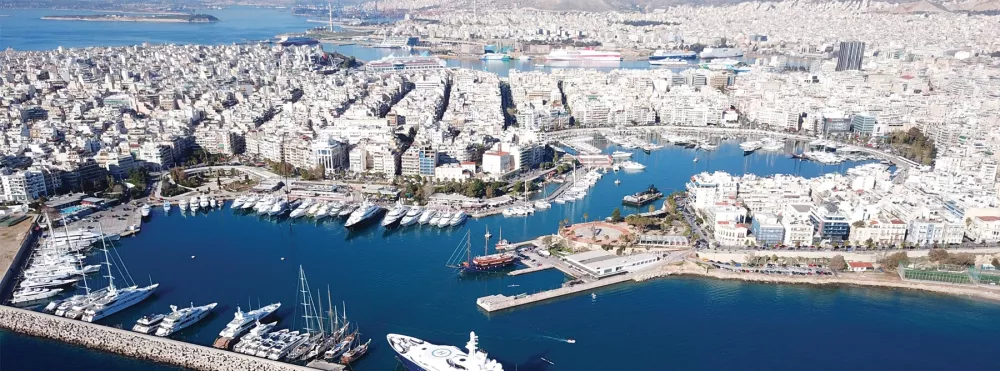
Project’s progress
What has happened with the project since its end date?
For information on the project's development, see Journal 1, Journal 2, and Journal 3.
- Maintaining structures: two milestones of the project were the Local Council for Crime Prevention (LCCP) (see Webarticle 4) and the Victim Support Unit (see Zoom-in 1). Earlier this year (February 2024) the LCCP held elections to appoint new members. Currently, the initiative comprises 11 volunteers, and among them, the police director the Piraeus Police Department. Regarding the Victim Support Unit, it has now been integrated into the Department of Public Health and Social Services. This ensures the continuation of services provided to victims, from legal counseling to psychosocial support.
- Networking and communication: the project has been active in dissemination activities with peers and other potential stakeholders and adopters of the BSFS actions. Cities such as Thessaloniki in Greece, Puerto-Mont in Chile and Yongrios in Hungary got in touch to get more information, especially about the CURIM app. Piraeus has been involved with the URBACT network “Cities after Dark” and the EUI C2C Exchange Program, which has allowed for knowledge sharing among city representatives, particularly with the city of Corigliano Rossano (Italy). The project has earned various awards for its approach with tech and public action.
What is the project’s plan for long-term sustainability?
The project’s plan has been focused on the pursue of additional funding opportunities, particularly through European Union funding programs -such as Horizon Europe, EUI, and URBACT (ITN Proposal for Replication and Transfer, Integrated Territorial Investment). This new funding will allow the introduction of other tech-based solutions such as sensors and cameras, and neighbourhood police officers. The BSFS project is considering obtaining funding through the National Recovery and Resilience Plan, also known as Greece 2.0. Through the LCCP, discussions have been held with the Mayor and Vice Mayors to assure the strategic alignment of the project’s actions -particularly regarding future investments and spatial actions- and municipal planning. This will allow the actions already carried out to remain a priority for resource allocation.
Generated Knowledge

Let’s imagine that an enterprising individual or collective came and asked the following question:
We would like to implement the BSFS actions in our city. Any advice?
In this section we are going to go over the lessons learned and we will present recommendations that would answer this hypothetical question:
1. Lesson learned: political support is key for the sustainability of the project.
Some of the project’s strongest aspects were leadership and the cross-department working. The project was supported by the municipal authorities of Piraeus, and this political support was maintained throughout the entire implementation phase. Backing was important for the legitimacy and functioning of the project, which allowed the MUA access to resources and networks that otherwise would have been difficult. The project aimed to create tools and carry out actions that required close cooperation with other departments in the municipality, such as the Victim Support Unit, the LCCP, and the school graffiti clean-up. Deputy mayors played a role in problem-solving and facilitating communication and cooperation between departments.
2. Lesson learned: communication about the project’s development should be constant, clear, varied, and adapted to target audiences.
The project had a multichannel communication strategy. The project used digital platforms -namely a website, social media pages, and email newsletters- along with more traditional media (print, TV, radio) to communicate with users about the actions taken and the availability of the new resources developed. Videos of the before and after states of the playground renovation were very informative and clear. Online communication proved to be essential to overcome the complications presented by COVID-19 lockdowns that happened during the first part of the project.
Throughout the project the city of Piraeus participated in dissemination activities to share the results of BSFS project, especially since the it ended and the results can now be shared in full. At this stage, communication with users was less of a priority.
These activities focused more on communicating with startups, Greek local authorities, etc. The EFUS, another partner in the project, created practice sheets, a white book, and other documents as a “BSFS-at-a-glance” support for parties interested in knowing more about the project.
When communicating with other city makers interested in your project, don’t hesitate to share the obstacles and shortcomings along with the success stories.
3. Lesson learned: Public procurement can be complicated (especially in the midst of a global pandemic)
Public procurement was one of the more challenging aspects of the project’s implementation. The project had to engage with providers for tech and equipment and comply with Greek law specifications. Additionally, delays in public procurement were also significant due to a highly troublesome and unforeseen condition: the COVID-19 pandemic.
Flexibility, adaptability and the capacity to modify the project’s targets were fundamental. For example, originally the idea was to secure abandoned buildings but legal constraints made it necessary to shift the spatial interventions towards schools. Likewise, the Victim Support Unit had to be relocated to an independent operations center to mitigate the delays caused by the pandemic. This actions were possible thanks to the cooperation of public officials who facilitated the communication with other local stakeholders and to keep the project moving.
4. Lesson learned: Participation should be a two-way street
Participation was another challenge for the project.
Overall, the project had a clear focus on institutional participation.
At an organizational level, difficulties arose to maintain constant attendance of the members of the LCCP, due to a lack of availability -as most of them are public officials- rather than a lack of interest.
As mentioned earlier, the COVID 19 restrictions posed many limitations. In this case, direct contact was restricted in the early phases of the project due to lockdowns and sanitary measures to prevent contagion.
However, the top-down approach of the project left little space for citizen participation, as the decisions of what actions to take were either already defined by the project or proposed by public officials. By design, the project ranked low on the IAP Spectrum of Public Participation (see Webarticle 3).
Regarding city dwellers, participation presented itself as a one-way street. They were mostly involved to give information about security, perception, and security-related incidents in the city through surveys and questionnaires. Students received training on cyber bullying, but there is no initial feedback to know if these were pressing concerns of the targeted population.
The project leaned heavily on technology as a solution for security -especially when it came to the CURIM app. While the app has attracted attention for its promise in data treatment for security, user retention and involvement were lacking. This is due to various factors, such as lack of familiarity. But mostly, it was due to the fact that the app’s goal was not to propose or give solutions to the problems identified by users. Therefore, there was little payback for city dwellers to get involved.
It is important not only to involve city dwellers as sources of information or of feedback on decisions taken at a higher level, but as part of the decision-making process. Tech can be of great utility, but there should be clear benefits of getting involved.
5. Lesson learned: Security is more than fear of crime
While actions towards security are commendable, the project focused heavily on a crime-centric approach, where the notions of “fear of crime” and “feelings of insecurity” were confounded when aiming to improve perception of security. This mix-up was reflected in various indicators used on the baseline measure of the local perception and the evaluation of the project’s impact. These are two very different concepts that require very different treatment. Crime is only one of the many elements that can make citizens have a negative perception of their environment: low crime does not necessarily imply a positive perception of security. And fear is not the only feeling triggered.
“Fear of crime” approaches focus on criminal offenses, prioritize quantitative aspects (surveys, sensors, reports), require low citizen participation (as previously shown, and the spatial actions aim to prevent crime opportunities.
On the other hand, “feelings of insecurity” approaches focus rather on cues (violence, incivilities, danger, crime), involve qualitative methodologies, require middle to high citizen participation, and their socio-spatial actions aim to prevent violence and foster social cohesion.
Conclusion

The BSFS project has many positive aspects. However, the strongest suit of the project’s implementation was its solid support from public authorities. And it is easy to see why: the project’s goal of improving security is concrete, clear, and an overall positive thing to do. Oftentimes, projects such as these that aim to solve an issue of importance for the local community are limited due to the lack of political backing. In this case, the project had the authorities’ trust. This opened various doors for the BSFS project in terms of communication and partnerships with departments in the municipality. And in the midst of a pandemic that required adaptability, these collaborations allowed the project to continue steadily in spite of the limitations. Another very positive aspect of this was the access to knowledge of the local context. The BSFS shows what a successful implementation with full support from local authorities. Authorities of Piraeus have an important lesson to share with other local authorities on how to lead and bolster a European-funded project for a positive impact at a city level.
The creation of the LCCP as a body of governance to understand local issues and take action is exemplary. The presence of key stakeholders from the city of Piraeus as volunteer members enhances the communication and the process of decision-making. Another aspect that BSFS can bring to the table of discussion is how to ensure the constant involvement of these public officials. Likewise, the Victim Support Unit established through BSFS is not only innovative but essential for the well-being of victims and the prevention of violence.
While actions on the front of institutional collaboration are interconnected and sustainable, actions beyond this appeared disjointed and with uncertain continuity -haphazardly assorting cyberbullying, data collection, and beautification of spaces, as if they were targets of opportunity. Each of these actions would merit an in-depth project and funding on their own. Hopefully, their introduction through the BSFS project can arouse interest to give each of these actions the attention they deserve.
Any future iterations of the project will have an important challenge ahead of them: citizen participation. Improving security benefits greatly from the participation of citizens: a collaboration with authorities, a dialogue where experts are open to “translate” the empirical knowledge of city dwellers into actionable projects. As mentioned, this derives from a heavy focus on crime as a trigger and fear as perception, and a conflation of “fear of crime” with “feelings of insecurity”. While preventing crime is a positive measure, it can be done without consulting city dwellers, and only focusing in preventing crime and combating fear leaves many significant gaps and many audiences unattended.
Lastly, the BSFS project could enhance its impact if it shared its complications and the obstacles it was unable to overcome along with its success stories. The project is singular and a “behind the scenes” look could provide a realistic depiction of what it is like to work in such an initiative.
With all of this said, the BSFS project is a step in the right direction to improve security in the city of Piraeus.
About this resource
The Urban Innovative Actions (UIA) is a European Union initiative that provided funding to urban areas across Europe to test new and unproven solutions to urban challenges. The initiative had a total ERDF budget of €372 million for 2014-2020.
Similar content



